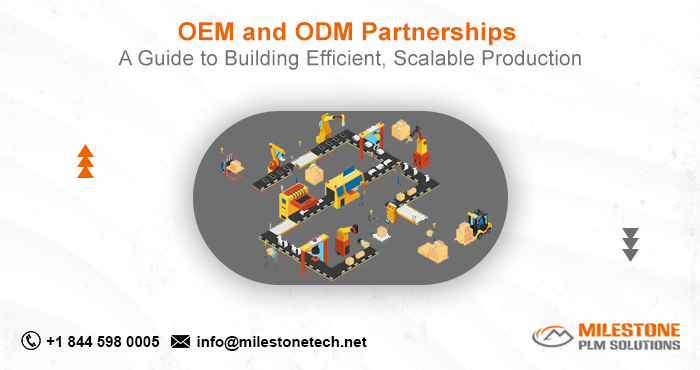OEM and ODM Partnerships: A Guide to Building Efficient, Scalable Production
- Milestone PLM Solutions
- Oct 30, 2024
- 3 min read
In the rapidly evolving world of manufacturing, Original Equipment Manufacturer (OEM) and Original Design Manufacturer (ODM) partnerships have become essential strategies for companies aiming to streamline their production, reduce costs, and innovate at scale. OEM and ODM models serve different purposes, yet both play crucial roles in achieving efficient and scalable production, depending on a business's needs and objectives. This guide delves into the essentials of OEM and ODM partnerships, their benefits, and key considerations for building successful collaborations.

Understanding OEM and ODM Models
OEM (Original Equipment Manufacturer): In an OEM partnership, a company manufactures products or components designed by another company and often branded under the customer’s name. OEMs follow detailed specifications provided by the client, ensuring quality standards and meeting branding requirements without engaging in the product’s initial design.
ODM (Original Design Manufacturer): ODMs, on the other hand, take on the responsibility of designing and developing a product based on the client’s concept or requirements. This approach allows companies to leverage the ODM’s expertise in R&D, technology, and design. ODMs often work with multiple clients and may make minimal alterations to their designs to suit individual branding and functional requirements.
Why Choose OEM and ODM Partnerships?
Cost Efficiency: Collaborating with OEMs or ODMs helps companies save on manufacturing and design costs. Both models allow brands to avoid significant investments in infrastructure, machinery, or extensive research and development.
Faster Time-to-Market: Leveraging an existing design or manufacturing infrastructure enables faster product launches, giving companies a competitive edge. For instance, OEM production allows companies to maintain a steady supply chain, while ODMs expedite innovation.
Scalability: Whether scaling a current production line or launching a new product, OEM and ODM partners bring flexibility to adapt to increasing demand without sacrificing quality. OEMs, in particular, can increase production volume based on customer forecasts, ensuring market demands are met.
Enhanced Focus on Core Competencies: By outsourcing design or production, companies can redirect internal resources to areas like branding, marketing, or customer service, ultimately adding more value to their brand without overextending their expertise.
Steps to Building an Effective OEM and ODM Partnership
Define Objectives and Requirements: To ensure the success of an OEM or ODM partnership, companies should have clear objectives and requirements. These should include production volume, quality standards, timelines, and cost expectations. Precise communication minimizes misunderstandings and sets a strong foundation for the partnership.
Evaluate Partner Capabilities and Experience: Conduct thorough due diligence on potential OEM or ODM partners. Evaluate their technical skills, production capacity, certifications, and market reputation. For OEM partnerships, their manufacturing reliability and adherence to quality standards are crucial. ODMs should have a proven track record of design innovation, intellectual property protection, and product development within relevant sectors.
Prioritize Quality Control: Quality control is non-negotiable in OEM and ODM collaborations. Regular inspections, audits, and adherence to certifications ensure that the final product meets the desired standards. Implement quality checkpoints at various production stages and maintain open communication to address any issues promptly.
Build Clear Contracts and IP Agreements: Contracts should specify production timelines, quality benchmarks, and terms regarding intellectual property (IP) rights. For ODM partnerships, IP agreements are particularly important, as they outline the ownership of design and technology, preventing unauthorized usage or replication.
Establish Transparent Communication: Effective communication builds trust and alignment between both parties. Regular meetings, updates, and clear reporting channels can mitigate risks, address challenges quickly, and keep production on schedule. Collaboration platforms, standardized feedback channels, and frequent updates enhance the overall efficiency of OEM and ODM partnerships.
Navigating the Challenges of OEM and ODM Partnerships
While OEM and ODM models bring numerous benefits, they are not without challenges. Here are some common obstacles and how to navigate them:
Intellectual Property Risks: Protecting proprietary designs and technologies is essential in ODM partnerships. To safeguard IP, companies should work with legally vetted contracts and partners with solid reputations.
Cultural and Language Barriers: When partnering with manufacturers overseas, communication barriers can arise. Using translators, defining clear roles, and hiring local consultants can help bridge these gaps.
Logistical Coordination: Shipping, customs, and regulatory compliance can complicate OEM and ODM partnerships, especially for companies looking to scale globally. A proactive approach to regulatory compliance and logistics planning is essential to avoid delays.
Conclusion
For businesses seeking efficient and scalable production, OEM and ODM partnerships offer unique opportunities to leverage specialized expertise, reduce costs, and enter markets faster. By understanding the distinctions between OEM and ODM models, defining clear objectives, and building robust partnerships, companies can effectively harness these models for sustained growth and innovation. In a world that demands rapid adaptability, OEM and ODM partnerships stand as vital strategies for companies aiming to thrive in today’s competitive marketplace.


